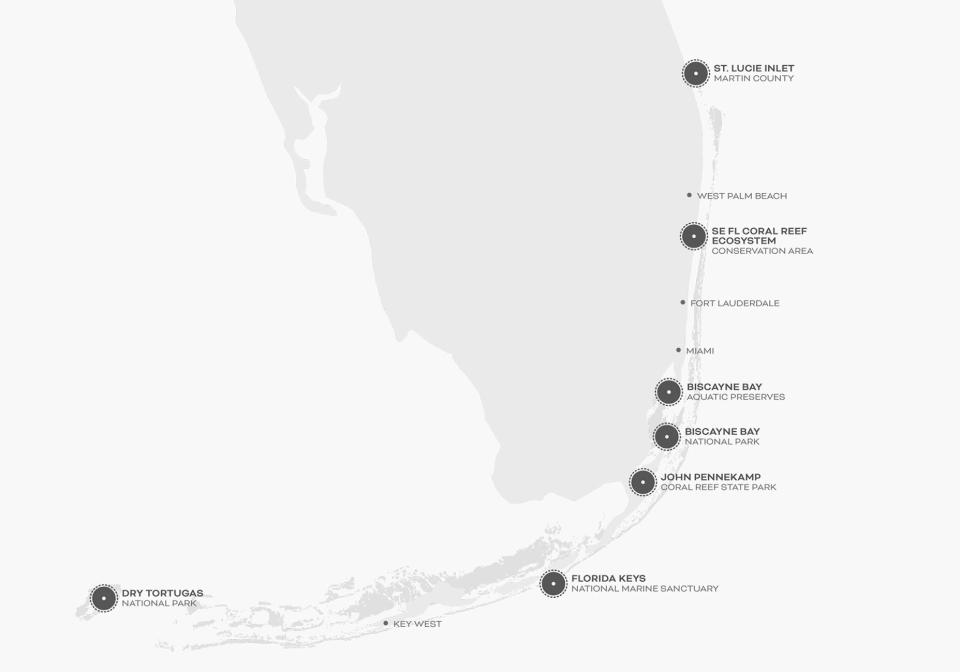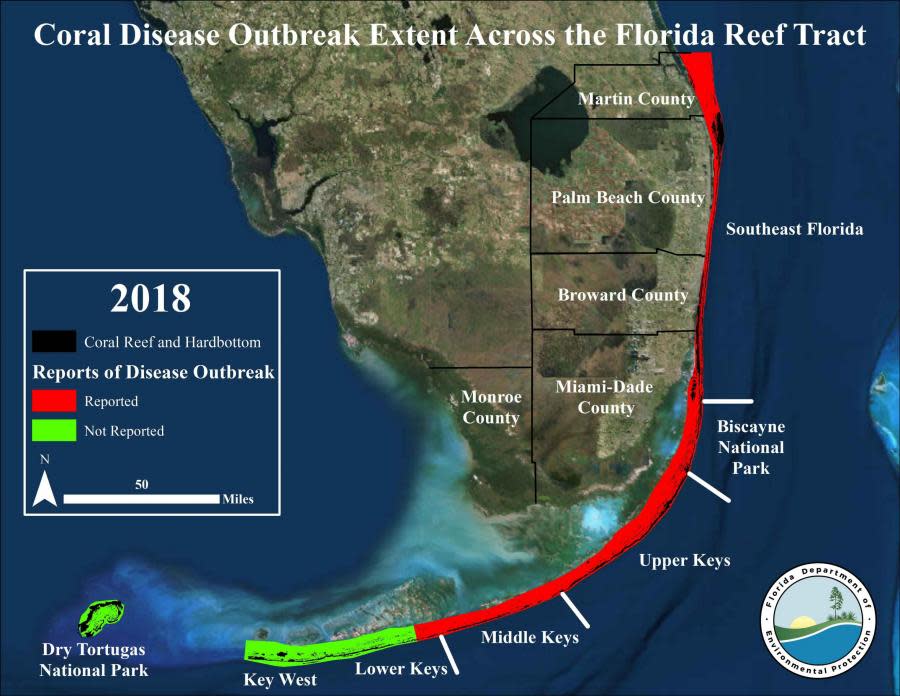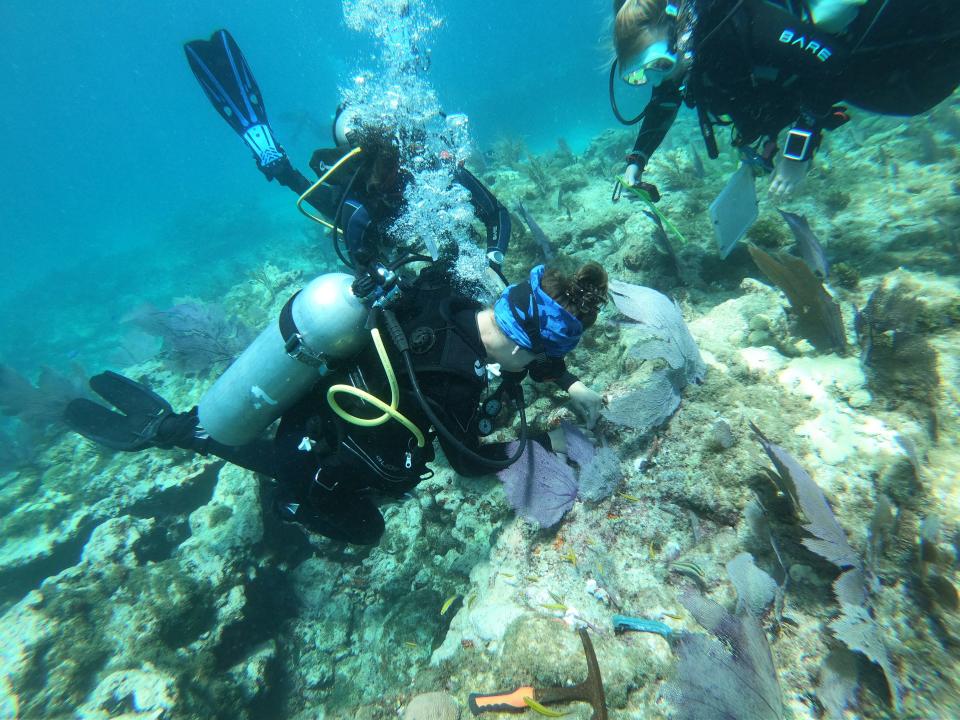Happy Coral Reef Awareness Week! What you need to know about Florida’s Coral Reef
Coral reefs are both beautiful and utterly vital to the ocean ecosystem and the local environment. They provide homes, food and breeding sites for millions of marine plants and animals, including the fish we eat. They offer important resources we've used to fight cancer, pain and inflammation. They help protect shorelines from extreme weather, erosion and flooding, and they provide income through fishing and tourism for millions of people.
Corals, animals that range in size from a pinhead to a softball, are invertebrates that become permanently fixed in place as they grow vibrant and colorful external skeletons. Individual corals, called polyps, grow slowly and form different shapes ranging from rocks, mushrooms, trees, graceful waving fans, even a human brain and more, depending on which of the hundreds of coral species they are. Sometimes they can be mistaken for plants. Some are even fluorescent.
When they connect with each other and other animals with the same structure they create, essentially, scaffolding for large communities in complex, wide-ranging reefs that support more species than any other marine habitat. Think of corals as trees in an underwater rainforest, supporting a rich, biologically diverse population of life underwater. Colonies of coral in the reef can live for hundreds of years.
In honor of National Coral Reef Awareness Week (the third week of every July), here's what you need to know about ours.
What is Florida's Coral Reef?
Florida's Coral Reef is the only coral reef system in the continental United States and the third-largest barrier reef ecosystem in the world.
Stretching nearly 350 miles from Dry Tortugas National Park west of the Florida Keys to St. Lucie Outlet north of West Palm Beach, it's made up of over 40 species of corals including one colony over 300 years old, according to the Florida Department of Environmental Protection (FDEP). About two-thirds of the Florida Reef Tract is inside Biscayne National Park and the Florida Keys National Marine Sanctuary.

It's also important to Florida. A large part of our fishing industry survives on fish that breed and grow in the coral reef.
"It also supports over 71,000 jobs and generates over $6.3 billion in tourism revenue every year,” said Darren Soto, D-Kissimmee, at an event for SeaWorld Orlando's new Coral Rescue Center in June. Millions of people come to fish, dive and snorkel around these reefs and see the brilliant fish and marine life dependent on them.
And the reef helps protect the coast, the first line of defense for a state that gets slammed with hurricanes and tropical storms every year. "Florida’s Coral Reef provides more than $355 million per year in flood protection benefits to buildings," the FDEP said on the floridascoralreef.org website, "and protects nearly $320 million in annual economic activity."
About 25% of the ocean's fish depend on healthy coral reefs
Coral reefs cover only a tiny area of the ocean floor — about 1% of the total marine habitat — but, like bustling cities, they provide homes and life to a wide variety of life.
"Coral reefs are among the most biologically diverse and valuable ecosystems on Earth," according to the U.S. Environmental Protection Agency. "An estimated 25 percent of all marine life, including over 4,000 species of fish, are dependent on coral reefs at some point in their life cycle. An estimated 1 billion people worldwide benefit from the many ecosystem services coral reefs provide including food, coastal protection, and income from tourism and fisheries."
Coral reefs are easily damaged
For something with such a powerful effect on the ocean environment, coral reefs are extremely fragile. Corals rely on algae living inside their tissues to provide nutrients. When the coral is stressed by changing water temperatures, pollution or too much sunlight, they expel that algae, causing the corals to "bleach" or turn white. Bleaching itself does not kill corals, but it leaves them susceptible to disease or starvation.
The primary cause of large regional or mass bleaching events is rising sea temperatures. These events, first noticed over 40 years ago, have become more frequent and more intense. The worst so far was the Great Coral Bleaching Event from 2014 through 2017, when already warm sea temperatures were increased El Niño, causing heat stress to spread across the world and into regions that had never bleached before, such as the north part of the Great Barrier Reef in Australia. Half of the coral reefs in the world were affected.
Coral reefs are also damaged by poor water quality, ocean acidification, sea level rise, tropical storms, pollution, storms, overfishing, bottom-trawling (dragging a weighted net across the seafloor), misplaced boat anchors, stress from high population densities and coastal development, sediment and nutrient runoff, direct contact by careless tourists and more.
Florida's reefs have been declining for the last 40 years, according to the EPA, with many of them losing more than half of their coral cover. Twelve coral species off our coasts have been designated as endangered. But the biggest threat facing Florida's reef for the last ten years is a disease.
Florida's coral reef is being attacked by a disease

"The Florida Reef Tract is currently under siege by a very lethal disease called Stony Coral Tissue Loss Disease," Jim Kinsler, zoological curator at SeaWorld Orlando and manager of the Florida Coral Rescue Center, told FLORIDA TODAY. "The disease, once a coral colony contracts it, is almost 100% fatal to that colony."
Biologists say Stony Coral Tissue Loss Disease, originally dubbed "white syndrome," is unprecedented and has been killing more than 20 Caribbean coral species and coral on Florida’s reefs since 2014. A study last year by NOAA and the University of Miami found 70% of the Florida Coral Reef is eroding faster than it's growing.
The disease began near Miami and has since spread through the northern extent of Florida's reef tract in Martin County, south through the Florida Keys, and west into the Marquesas, according to the Florida Fish and Wildlife Conservation Commission.
The precise cause is unknown.
There's a plan to save Florida's coral reef
In December 2019, the National Oceanic and Atmospheric Administration enlisted The Florida Aquarium, the Coral Restoration Foundation, Florida Department of Environmental Protection, Florida Fish and Wildlife Commission’s Fish and Wildlife Research Institute, Mote Marine Laboratory & Aquarium, Reef Renewal and The Nature Conservancy to join in a $100 million effort called Mission Iconic Reefs to restore coral at seven sites along the Florida Reef Tract, off the state's southern tip.
That plan has an ultimate goal of restoring 3 million square feet of coral reefs — roughly the size of 52 football fields — by 2035 by planting hundreds of thousands of coral fragments to promote reef growth and thousands of Carribean king crabs to eat algae and make the environment more hospitable. SeaWorld Orlando's Coral Rescue Center is working to store the most resilient coral genetics in the hopes of creating disease-resistant coral to transplant back into the wild.
You can help save Florida's Coral Reef

The Nature Conservancy has some suggestions to help protect Florida's Coral Reef.
Avoid touching coral. When you dive, don't touch the reef. Corals are living animals and contact can damage them. Avoid stirring up sediment, which can smother corals. When boating or fishing, be mindful of where you go and especially where you drop anchor.
Use mineral-based sunscreens. Chemicals like oxybenzone and octinoxate, used in many sunscreens, can damage corals and decrease their defenses against bleaching. Look for sunscreens that use non-nano zinc oxide as their active ingredient.
Eat sustainable seafood. Research where your seafood comes from and if it's caught sustainably. Skip the parrotfish: they eat algae off coral reefs, cleaning the reefs and helping the corals stay healthy and thriving.
Pick up your trash. Millions of tons of trash end up in the ocean and it can damage marine life, including corals. On the beach or on the water, pick up your trash or any that other people have left behind.
Make your lawncare green. Even if you live hundreds of miles away from the coral reef, the stuff you put on your lawn will eventually flow into the water system. Use green alternatives for fertilizer and pesticides that won't harm marine life.
Volunteer. If you're in the area, the Coral Restoration Foundation is always looking for volunteers in and out of the water. Divers (with proper certification) can help with nursery work, transplanting corals and monitoring their health. Land-based volunteers help build coral trees, help in the Education Center and conduct community outreach. Divers also can help the Mote Marine Laboratory with its Bleachwatch to monitor and report on conditions. The Reef Environmental Education Foundation holds the Great Annual Fish Count every July to encourage recreational divers and snorkelers to conduct fish surveys while they're down there, but you also can do that all year round. If you're not ready to jump in the water just yet, all of those organizations gladly accept donations.
This article originally appeared on The Daytona Beach News-Journal: Florida's Coral Reef: 5 things to know about the world's 3rd-largest

